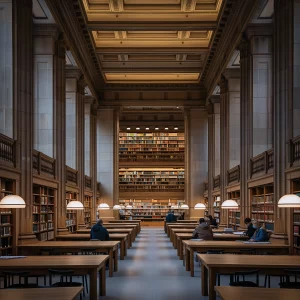London, a city steeped in history and culture, boasts an array of libraries that are not just repositories of books but are gateways to the past, present, and future. These libraries, ranging from Gothic to Brutalist, Victorian to Edwardian, and modern architectures, serve as cultural sanctuaries and academic strongholds. They offer quiet, knowledge-rich environments with comfortable study areas and inclusive public access.
This exploration explores the architectural and historical diversity, cultural significance, extensive collections, and role of these libraries in community engagement and education.
Architectural and Historical Diversity
London’s libraries are a testament to the city’s rich architectural heritage and historical depth. From the grandeur of the Gothic revival to the stark functionality of Brutalist structures, the variety in design reflects a tapestry of London’s societal evolution over the centuries. For instance, with its vast collection of over 150 million items, the British Library is an architectural marvel of the 20th century, designed to house an ever-growing repository of the world’s knowledge. The Maughan Library, part of King’s College London, showcases the neo-gothic architectural style, housing an impressive collection within its storied walls.
Victorian and Edwardian libraries dot the landscape, each with its unique design and purpose. The Guildhall Library focuses on London’s history, encapsulated within a structure that has seen the city evolve. Meanwhile, the modern Canada Water Library demonstrates how contemporary design principles can create beautiful and functional spaces catering to today’s public needs.
Cultural and Academic Havens
Libraries in London are not merely buildings filled with books; they are cultural beacons and academic fortresses. They provide serene and stimulating study, research, and leisure reading environments. Comfortable study areas and reading rooms invite patrons to delve into collections that span global histories, local narratives, and specialised subjects such as art, medicine, and film.
The National Poetry Library, housed within the Southbank Centre, boasts the world’s largest poetry collection, demonstrating London libraries’ commitment to both breadth and depth in their collections. These institutions serve as inclusive spaces, offering public access to knowledge and resources.
Extensive Collections
London’s libraries are renowned for their extensive and diverse collections. The King’s Library, housed within the British Library, contains historical books and manuscripts collected by King George III, offering a glimpse into the intellectual interests of the past. The Wellcome Library focuses on the history of health and medicine, providing invaluable resources for researchers and the public.
Specialised resources abound, from the National Art Library’s focus on the visual arts within the Victoria and Albert Museum to the film and video archives catering to cinephiles and industry professionals. These collections not only support academic and professional work but also enrich the cultural landscape of London, making it a hub for learners, creators, and thinkers from around the world.
Public Engagement and Accessibility
Libraries in London stand as pillars of community engagement and education. They host many educational and literary events, workshops, and exhibitions open to the public, fostering a sense of community and encouraging exploration and discovery. Digital resources have expanded the reach of these institutions, allowing global access to collections and services, and emphasising the principle of public access and community-centric values.
Senate House Library, with its affiliation to the University of London and its connection to notable literary figures like George Orwell, exemplifies the role of libraries in public engagement. It hosts events and exhibitions that draw connections between literature, history, and society, inviting visitors to explore deeper narratives and ideas.
Historical and Literary Significance
Many of London’s libraries have significant historical and literary connections. They have inspired literary giants, served as backgrounds in films, and played roles in historical events, such as WWII. The Guildhall Library, focusing on London’s history, and Kensington Central Library, notable for its architectural interest, are hubs for those interested in exploring the city’s past and its impact on literature and the arts.
These libraries not only preserve and promote the history and literary heritage of London but also inspire contemporary writers, filmmakers, and artists. Their collections and archives are treasure troves for researchers, offering insights into the social, political, and cultural fabric of different eras.
Key Institutions and Their Collections
Diving deeper into the heart of London’s literary landscape, we encounter key institutions that hold vast collections and embody the city’s intellectual and cultural heritage. The British Library stands as a colossus among these, with over 150 million items, including manuscripts, maps, newspapers, and prints, making it one of the largest libraries in the world. Its significance extends beyond size; it’s a centre for research, learning, and cultural engagement, offering exhibitions that bring literary and historical treasures to the public eye.
Senate House Library, another cornerstone, serves the University of London’s academic community but also opens its doors to the public, offering access to a wide range of collections, including those that inspired George Orwell’s dystopian visions. Its historical and architectural significance and rich collections make it a beacon for students, researchers, and literary enthusiasts alike.
The Guildhall Library focuses on London’s history, and the Kensington Central Library, with its architectural intrigue, offers specialised resources that delve into the city’s past and present. Their collections cater to those interested in London’s socio-economic, cultural, and architectural development, providing insights into the city’s evolution through the ages.
With its interactive spaces and modern exhibitions, the Wellcome Library emphasises the intersection of medicine, life, and art, showcasing the importance of health and well-being throughout history. The National Art Library at the Victoria and Albert Museum highlights the significance of visual arts, offering public access to a diverse collection that spans centuries and continents.
Design and Functionality
The architectural beauty and functional spaces of London’s libraries contribute significantly to their allure and utility. The neo-gothic Maughan Library, with its historical ambience and state-of-the-art facilities, caters to the academic needs of its patrons while providing a visually stimulating environment. Similarly, with its modern design, the Canada Water Library exemplifies how contemporary architecture can create inviting and versatile public spaces that encourage learning, creativity, and community interaction.
These institutions demonstrate how design and functionality are intertwined, with each space thoughtfully crafted to enhance the user experience, from the layout of reading rooms and study areas to the accessibility of digital resources and collections. The attention to architectural detail and user-centric design reflects London’s libraries’ commitment to fostering environments that are aesthetically pleasing and conducive to study, research, and communal engagement.
Community and Educational Programs
London’s libraries are pivotal in fostering community spirit and educational growth. Through various programs, workshops, and events, these institutions engage with the public, encouraging exploration, learning, and cultural exchange. For example, the Library and Museum of Freemasonry offers unique historical insights through its collections and exhibitions, drawing connections between Freemasonry, London’s history, and wider cultural contexts.
St Bride Library, with its focus on printing and graphic arts, provides workshops that not only educate but also celebrate the craft and history of printing. These workshops invite participants to engage hands-on with the materials and techniques that have shaped communication over centuries. These programs, along with countless others offered across London’s libraries, highlight the institutions’ roles not just as repositories of knowledge but as active, dynamic centres for learning and discovery.
The Role of Libraries in Modern Society
As we explore the depth and breadth of London’s libraries, we see their evolving role in modern society. Beyond their traditional functions, these libraries act as cultural hubs, connecting individuals with the arts, sciences, and humanities in a rapidly digitising world. They offer sanctuary and inspiration, providing spaces where the community can learn, explore, and create.
The emphasis on digital accessibility and online resources reflects a commitment to inclusivity and adaptability, ensuring that physical constraints do not bind knowledge. Through their extensive collections, educational programs, and community-centric initiatives, London’s libraries continue to champion the values of literacy, learning, and cultural engagement, playing a crucial role in shaping an informed, thoughtful, and connected society.
In conclusion, the journey through London’s library landscape reveals a rich tapestry of history, culture, and knowledge. These institutions testify to the city’s enduring commitment to learning and intellectual exploration. As we celebrate their contributions to academic excellence, cultural development, and community engagement, we recognise the indispensable role they play in the life of the city and its inhabitants. Exploring London’s libraries is not just a tour of physical spaces but an invitation to engage with the collective memory, creativity, and spirit of a city that continues to inspire and educate.



